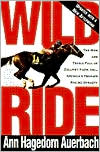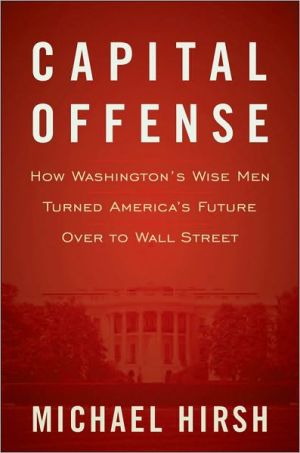Wild Ride: The Rise and Tragic Fall of Calumet Farm Inc., America's Premier Racing Dynasty
An award-winning writer chronicles the tragic story behind the downfall of horse racing's crown jewel.Founded in 1924 by Chicago mogul William Monroe Wright, Calumet Farm was to the world of thoroughbred racing what the New York Yankees are to baseball -- a sports dynasty. The stable bred so many superstars that it became the standard by which all achievements were measured in the horse racing industry. But during the 1980s, a web of financial schemes left Calumet destitute. Wild Ride is Ann...
Search in google:
Using many never-reported facts, award-winning writer Anne Hagedorn Auerbach chronicles the compelling and tragic story behind the downfall of Thoroughbred racing's crown jewel. Library Journal Journalist Auerbach untangles the spiderweb of financial machinations that enveloped, consumed, and ultimately destroyed one of the most famous horseracing stables in the world. Through three generations of the Wright family, Calumet led, lost, and regained its preeminence as a breeding farm and racing stable only to lose everything, including the family's fortune, in the fourth generation. Chronicling the history of Calumet and its fall into the depths of massive debt, this well-researched, fast-paced book sheds new light on the destruction of Calumet and exposes the excesses of the 1980s. Highly recommended.-Susan Hamburger, Pennsylvania State Univ., University Park
Wild Ride 1\ Calumet Farm sits on a high plateau in central Kentucky, a land of rolling savannahs known as the Bluegrass and the world center of the thoroughbred horse industry. Here, partly because of an accident of nature, breeders have produced more champion racehorses than on any other piece of land in the world.\ The geological accident occurred more than 450 million years ago. At that time, while the eastern United States was still under water, great collisions on the earth’s surface forced the formation of mountains where the Appalachians stand today. Over the next 200 million years, a pattern emerged: the mountains eroded, the collisions resumed, and new mountains rose, only to erode once again. As each range of mountains formed, the impact sent waves of the earth’s crust westward. Of the many waves, one grew until it formed a high ground that consisted largely of limestone and measured fifty miles across and several hundred miles long, extending from what is now Ohio to southern Tennessee.\ On the surface of this high ground was a dark brown soil, nourished by the limestone beneath it and uncommonly rich in phosphate from millions of deposits of shells and skeletons. The soil also contained an abundance of calcium, but it was the phosphate, normally found at such concentration only on ocean floors, that would dazzle geologists for centuries. The grass that grew from this soil was unique in its ability to nurture strong bones in the animals that grazed upon it. And the greatest concentration of the soil was in a 2,500-square-mile area whose center would someday be Fayette County, Kentucky, the heart of the Bluegrass.\ Thousands of years after the first grass grew on the high plateau and many miles away, horse breeders in England began a centuries-long pursuit that would have as much impact on the future of the Bluegrass as geology. Their quest was the search for a new type of horse to take advantage of a new kind of weapon—gunpowder.\ Horses were used mainly to transport men, supplies, and weapons until the Normans, in 1066, won the Battle of Hastings with the help of superior horses. For several centuries thereafter, the breeding of a sturdy mount capable of carrying the 350-pound weight of a knight in full armor was a critical part of military strategy. But with the invention of gunpowder in the fourteenth century, armor became obsolete and armies needed fast, agile horses capable of darting quickly out of the range of fire. In the Middle Ages, though, the only light horses in England didn’t have the stamina for war, while the strong horses were too slow.\ For centuries the English tried, without success, to create the perfect steed. By the sixteenth century, not only armies sought the new breed, but horsemen did, too, because racing was growing in popularity, especially in the royal courts of James I, Charles II, and Queen Anne. For the inventive breeder who could find the right combination of speed and stamina, there were big profits to be made. The breakthrough came in the late seventeenth century when the English began breeding their mares to stallions from North Africa and the Middle East. From these matches came the “invention” of the thoroughbred horse.\ Every thoroughbred’s male line extends back to one of three sires: the Byerly Turk, the Darley Arabian, and the Godolphin Barb. Captain Richard Byerly captured the first of these, a black warhorse, during a 1688 battle in Turkey, shipping it to England in 1689. Around 1704 the merchant Thomas Darley purchased the second stallion in Syria and sent it to his brother, a breeder in England. By most accounts a North African ruler sent the third stallion, born in Yemen in 1724, as a gift to the king of France. But the king didn’t like the looks of the horse and discarded it. A few years later, a Frenchman walking along the streets of Paris noticed a horse with welts on its back and wounds on its legs pulling a cart. He rescued the horse, which was the Yemen stallion, nursed it back to health, and sold it to the second earl of Godolphin, who then took the stallion to his farm in Newmarket, England, to breed with his finest mares.\ The new breed ranged in size from fourteen hands—a hand measures four inches—to seventeen hands tall from ground to withers (the point where the base of the neck and top of the shoulder meet), with powerful muscles, especially in its hindquarters, to propel its stride. Bred for speed, it had a high-strung, fiery nature, which gave it the classification, in breeding parlance, of a “hot blood,” as opposed to a “cold blood” like the heavy animals used to support the armored knights and the horses that toiled in fields. A lithe, elegant animal with the grace of a gazelle and the endurance of a larger mammal, the thoroughbred was capable of carrying weight while running at high speeds.\ During the last half of the eighteenth century hundreds of thoroughbred horses were shipped from England to the New World, where racing was in vogue and the demand for faster and faster horses was high. Horse racing had become so popular on the streets of colonial towns that it was considered a public nuisance. Soon tracks dotted the landscape from New York and Virginia to Maryland and the Carolinas. Even George Washington indulged; a 1772 diary entry shows that he had lost one-sixth of a pound at a track in Annapolis.\ Thoroughbreds didn’t arrive on Kentucky’s high plateau until about 1800, thirty years after Daniel Boone’s first expedition to what was then the untamed sector of Virginia. It was Boone, on his 1769 trip, who might have brought the first horses to the region, though they were probably only pack animals. Still, it was Boone’s splendorous tales that lured others with better horses to the lush rolling savannas. Accounts of his two-year trip gushed with descriptions of a land covered with dark soil that grew an abundance of herbs, wild rye, and wild lettuce and that fed a bountiful supply of game, including turkey, deer, bear, and buffalo. There were walnut trees, blue ash, buckeyes, and the biggest oak trees he had ever seen.\ Soon a rush of settlers from the Carolinas, Maryland, Virginia, and Pennsylvania crossed mountains and coal-filled valleys to settle on the high plateau. Most were from Virginia, where horsemen were by far the best among the New World’s breeders, a skill they took to the new land. And although none knew of the events of 450 million years before or were aware of the unique composition of the soil and grass, early annals show they did acknowledge the weather as a significant factor in raising their horses. Similar to parts of England and Ireland, the high plateau was temperate. Foals and yearlings were spared the harsh cold of the North and the even harsher heat of the South. And the new grass of spring came in as early as mid-March, at least a month before what most of the settlers were accustomed to. This meant the grass was edible by late March or early April, giving newborn foals early nourishment, a head start for building strong bones.\ The first time on record that the grass was referred to as “the Bluegrass” was apparently in a 1795 ad in the Kentucky Gazette, selling a plantation “rich with the Bluegrass.” Though the phosphate-rich soil gave the grass unique qualities and the term “Bluegrass” would help to market sales of the land and its products for centuries to come, the strain of grass itself was probably not indigenous to the high plateau, and it was not all that blue.\ The grass was part of the Gramineae family and the genus Poa. In Kentucky the strain was Poa pratensis, which means literally meadow grass. It is unclear how it ended up in Kentucky; filling the gaps of historical fact is a mountain of folklore about its origins. Some say the grass came from England during the last twenty-five years of the eighteenth century. In one story, an Englishman who accompanied Boone to Kentucky brought the seed. Another tale claims a settler carried the seeds in a thimble from England. Yet another credits a man named Blue who supposedly migrated from Pennsylvania, spotted the grass already growing in Kentucky, and named it after himself. Another account attributes the label Bluegrass to a simple mixup of names. A strain of the same genus, Poa compressa, found in parts of Canada does in fact have a discernible blue tint.\ The grass in Kentucky is remarkably thick and lush, growing eighteen inches to twenty-four inches tall and rippling in the wind in the same memorable way as a field of wheat in Kansas. Its deep green hue in springtime is startling in its intensity, especially on a sunny day. And in the early morning light, as the sun’s rays reflect off dewy blades of grass, its tint is slightly mauve, which might be why some nineteenth-century landscape artists in Kentucky painted the grass in tones of pink. Just how blue it is differs from one account to another. Some locals say they’ve never seen the blue. Others were told as children they could see blue grass on the night of a full moon if they stood in a field, bent over, and looked upside down between their legs. Still others say that the grass, when producing its tiny seeds and in full bloom, really does appear slightly blue usually for a week or ten days in late May or early June.\ By the late eighteenth century, the first families of the Bluegrass—the Alexanders, the Dukes, the Warfields, the Clays—were planting their roots deep in Kentucky soil. Most who made the journey were English, Irish, Scottish, or Scotch-Irish. It was a group that stuck together in a remarkable way, living, working, loving, marrying, and begetting among themselves generation after generation.\ The families came largely from Virginia. They were often wellborn, headed by the second and third sons of wealthy landowners who knew their older brothers would inherit the family land and so wanted their own manors and estates. They replicated the Doric-columned mansions of their homeland, bringing with them a band of servants and a repertoire of patrician tastes and habits. For them, breeding horses was already a third-generation pursuit. And because of them, the social and political institutions of the high plateau, including slavery, would always be firmly grounded in Virginia, though Kentucky severed its legal ties in 1792 and became a state. Together, the clannish, cultured Virginian and the independent, hard-bitten settler generated a new breed of American, the Kentucky gentry.\ Breeding horses quickly became a lucrative business and so popular that laws were passed to restrain ambitious horsemen from breeding their stallions in public squares. The region’s reputation for producing good racehorses soon reached the nation’s capital, where the government ordered the U.S. Army in 1792 to buy its horses only from Kentucky breeders. And in 1797, newspaper ads of the period indicate the first thoroughbred stallion arrived in the Bluegrass. Blaze, a dark chestnut born in England, was shipped to Virginia in 1793 and four years later to Kentucky, where his stud fee was twelve dollars.\ To be the best of the breeders, the Bluegrass needed an edge over its competitors in Virginia, Maryland, New York, and the Carolinas. That meant bringing in money from outside the region, luring investors out of their homeland and into Kentucky. Then, as now, that meant publicity.\ In 1839, in a clever marketing scheme, a Louisville man named Yelverton Oliver promoted a racing series that would give Kentucky the attention it needed. At a Louisville track, two of the nation’s champion racehorses, Kentucky-bred Grey Eagle and New York-bred Wagner, would compete in four one-mile races. Posters advertising the event were plastered on lampposts and trees from Chicago to New York. Spectators included half the population of Louisville and scores of visitors such as William T. Porter, the editor of a New York paper, Spirit of the Times.\ Wagner won the series by a neck, and the races were so gripping, so popular, and so profitable that Oliver arranged another series, of three races, two days later. Even more people pressed against the rails and placed their bets. Grey Eagle won the first race; Wagner won the second. The crowd went wild when in the last race, the horses were running neck and neck. Then suddenly, Grey Eagle broke his leg. Though the Kentucky-bred horse would never race again, the event, with the help of Porter and other journalists, led the Bluegrass out of obscurity.\ But what secured the future of the Bluegrass as the horse capital of the nation and then the world were three much bigger events, the first being the panic of 1837.\ During the 1830s speculative fever had reached a high point, not unlike that in America in the 1980s. Prices of everything from land to horses to sewing machines soared, and money poured into every business from the burgeoning coffers of individual investors and from banks. Horse breeders, mainly in Virginia, Maryland, New York, and North Carolina, were no exception. They borrowed heavily from the banks and the investors to expand their acreage and stables, and they brought in so much money from selling each crop of horses that every year they doubled and tripled the number of foals they produced.\ Kentucky breeders, meanwhile, abstained from such indulgences. Competitors called them “stodgy,” “self-centered,” and “backward,” but the Bluegrass farmers continued the practice of breeding the same numbers of stallions every year to the same mares owned by the same families with whom they’d done business for generations. Their operations remained selfsufficient.\ When the economy collapsed in 1837, breeders in other states were stuck with an oversupply of a product no longer in demand. Prices plummeted, and the horse industry took a dive—except in the Bluegrass, where greed had not overwhelmed common sense.\ With the Kentucky breeders riding high, the success of a horse named Lexington—the second big event—brought them further renown. A foal of 1850, Lexington won six of seven big races and earned nearly $57,000, making him third among the nation’s leading money winners. But it was in the breeding shed that Lexington, who for many years of his stud career was blind, would make history. No stallion before or since would sire as many winners as Lexington had, though some, like Bull Lea, Northern Dancer, and Alydar, would come close. Between 1865 and 1880, the sons and daughters of Lexington accounted for 50 percent of the winnings of all races in this country. So important was he to the history of the American thoroughbred that his skeleton, standing erect, was placed on permanent display at the Smithsonian Institution.\ The other event was the Civil War. Though fierce battles were fought throughout Kentucky, the state was officially neutral, and the devastation it suffered was far less than in the Carolinas and the rest of the South. The breeding industry remained intact in the Bluegrass and even improved, owing to the presence of Lexington. Breeders across the South, where racing was temporarily defunct, shipped their finest stallions to the Bluegrass for breeding. At the same time, the Kentucky breeders who had joined the cavalry returned home in their uniforms and their heavy boots. They would soon be known as “Kentucky hardboots”—horse traders who drove hard bargains, drank hard whiskey, and sold the finest horses in the nation.\ Soon the high plateau of central Kentucky became the undisputed thoroughbred breeding mecca of the New World—a solid position until the aftermath of the 1980s when many horsemen succumbed to the temptations their ancestors in the 1830s had resisted. For nearly 150 years, however, Bluegrass breeders would dodge the bullets of cyclical downturns in the nation’s economy, banding together in hard times and, in good times, astutely managing their crops of horses to keep the quality high and the production low enough to maintain strong demand in worldwide markets.\ By the 1940s, more than half the nation’s champion racehorses would come from the Bluegrass, but what would bring the greatest recognition to Kentucky-bred horses, spurring global demand beyond anyone’s expectations, were the champions of Calumet Farm. These were the crops of Warren Wright, whose father migrated to the Bluegrass country in 1924.\ Copyright © 1994, 1995 by Ann Hagedorn Auerbach
\ Library JournalJournalist Auerbach untangles the spiderweb of financial machinations that enveloped, consumed, and ultimately destroyed one of the most famous horseracing stables in the world. Through three generations of the Wright family, Calumet led, lost, and regained its preeminence as a breeding farm and racing stable only to lose everything, including the family's fortune, in the fourth generation. Chronicling the history of Calumet and its fall into the depths of massive debt, this well-researched, fast-paced book sheds new light on the destruction of Calumet and exposes the excesses of the 1980s. Highly recommended.-Susan Hamburger, Pennsylvania State Univ., University Park\ \







